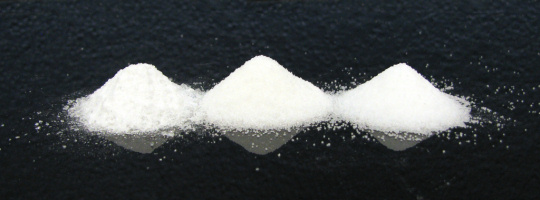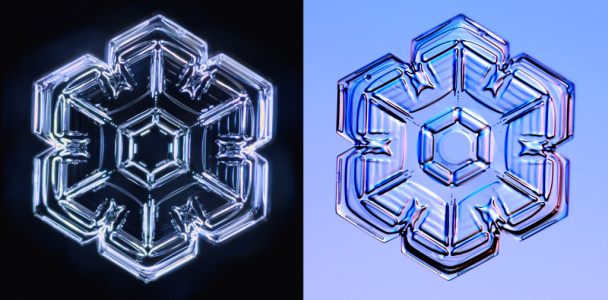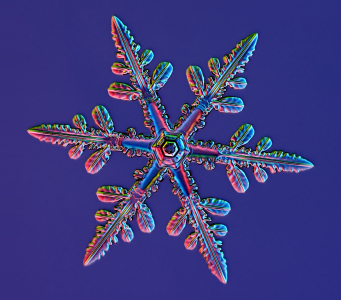|
| Snow crystals are made of ice, and ice is clear,
like glass. If you look at an individual snow crystal under a
microscope, it looks clear, like a small piece of shaped glass. So why
does a snowbank look white? |
|
 Clear as Glass, White as Snow Clear as Glass, White as Snow
The
picture on the right shows small piles of salt, sugar, and crushed
glass (from left to right). All three of these materials are
intrinsically colorless and transparent (glass especially so), but the
piles look white because they reflect light instead of absorbing it.
When
a ray of light hits a pile of glass bits, some of the light reflects
off the surfaces of the grains, while some is transmitted through the
transparent glass. But some of the transmitted light then reflects off
more grains, and then off more grains. The result of all these
countless reflections is that nearly all the light is reflected, and
little is absorbed. And that very property is what makes something look
white.
A snowbank looks white for the same reason -- light
reflects off the surfaces of all those countless snow crystals. A cloud
looks white for the same reason, except the light reflects off small
water droplets (which are also clear).
|
|  Light and Snowflakes Light and Snowflakes
This
tmage at right shows two photographs of the same snow crystal taken in
different lighting. The first photo used reflected light, so this is
about what the crystal would look like if you lobserved it on a black
mitten. Notice how the surface markings and edges reflect light, and
thus appear bright. But the smooth ice areas on the interior look
clear. This is just how a piece of shaped glass would look.
The
second photo used colored lights that illuminated the crystal from
behind, so the camera sees a bright background behind the crystal.
Now clear ice bends the rays of light, as would a complex lens,
giving the photograph a sense of depth and accentuating the crystal’s
internal structure and patterning.
We often illuminate using
colored lights this way, because this highlights the structural
features and can create a variety of pleasing photographic effects. The
first images looks nice also, but you can see more of the ice structure
in the second.
In the second photo you can also see how I used
some red light off to the side, which gave the crystal some subtle red
highlights. Whenever the mood suits me (and it usually does), I like to
add some color to my snow crystal photographs. |
|  A Rainbow Snowflake A Rainbow Snowflake
This
photos was also taken using illumination from behind, but this time I
used a rainbow filter to illuminate the crystal with all different
colors from different angles. The result is a very colorful snow
crystal photograph.
The photo was not taken using polarized light (as people often think), and the colors were not
added digitally later. This is pretty much what the photo looked like
when it came out of the camera. The color comes from illuminating the
crystal with colored lights. The ice bent the light in complex ways,
yielding the colorful highlights you see here. | | | | |
|
|
|
